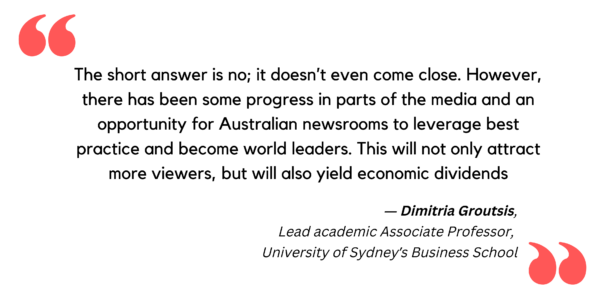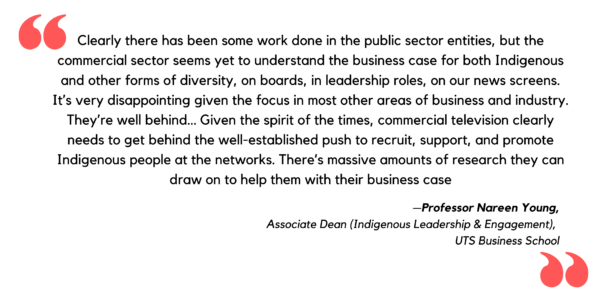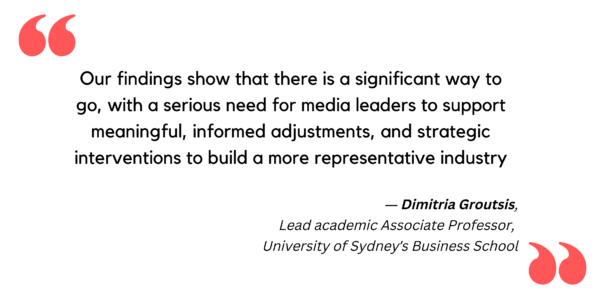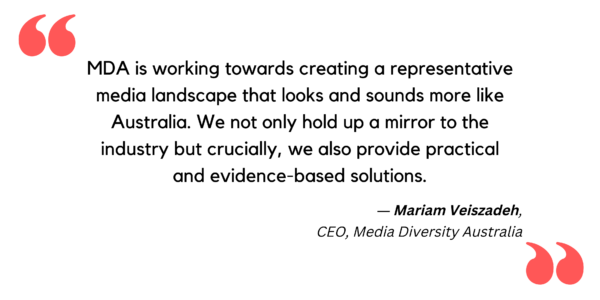
Who Gets to Tell Australian Stories? 2.0
Check out this new report: ‘Who Gets to Tell Australian Stories? 2.0’, examining Indigenous and cultural diversity of Australian news and current affairs television media. The report finds that Australian news and current affairs still doesn’t represent the society they serve. Congratulations to our friends at Media Diversity Australia and partners University of Sydney and University of Technology!
Media Diversity Australia (MDA) in partnership with the University of Sydney and University of Technology Sydney has released a ‘report card’ on Indigeneity and cultural diversity in television news, with insights into what has changed, what has stayed the same, and opportunities to lead the charge toward greater diversity.
Who Gets to Tell Australian Stories? 2.0 examines the Indigenous and cultural diversity of Australian news and current affairs television media – and asks – “Does Australian news and current affairs represent the society they serve?” given the latest Census data revealed Australia is more diverse than ever.

The report card comes two years after MDA released the landmark report Who Gets To Tell Australian Stories? The 2020 research provided baseline findings on the stark lack of cultural diversity in television news and current affairs, both on and off screen, which made headlines across the nation and around the globe.
Who Gets to Tell Australian Stories? 2.0 (2022) provides an update on what has changed, what has stayed the same and the opportunities to lead change. The findings show that there is some way to go, with a serious need for media leaders to support meaningful and informed adjustments, interventions to build a more representative industry.
- Who appears on our screens is more Anglo Celtic, however there are pockets of progress
- In leadership positions there’s slightly better representation on the gender front, but cultural diversity remains poor
- Non-European Australian audiences have least trust in news and most concerned about representation
- Newsroom staff more positive about industry’s attitude to diversity
- Regional newsroom often seen as a talent pipeline, but diversity issues even more stark
Who Gets to Tell Australian Stories? 2.0 has five studies combining qualitative and quantitative data on the:
- Indigenous and cultural diversity representation of reporters and presenters
- The diversity of network boards and editorial leaders
- A survey of attitudes of journalists working in newsrooms
- Interviews with regional newsroom leaders
- Representative sample of Australian viewers who were polled about their views on representation in news and current affairs
The report details the experience and the extent of inclusion and representation of culturally diverse news and current affairs presenters and reporters. It is also the first forensic examination of how our media treats cultural diversity at the workplace level.

Who appears on our screens is more Anglo Celtic, however there are pockets of progress
- The overall share of appearances on television by presenters and reporters of Anglo-Celtic background increased from 2019 to 2022. The Anglo-Celtic category remained vastly over-represented on television, across all states and territories.
- The share of appearances on television by presenters and reporters of Indigenous background improved overall but was inconsistent across networks.
- The share of appearances on television by presenters and reporters of European cultural backgrounds declined.
- Australia’s non-European population is 16 times greater than the representation on commercial networks (where it was just 1.3% of on-air talent).
- The non-European category remained the most severely under-represented, particularly on commercial networks.
- Nine is the only network to decrease its portion of Anglo-Celtic on-air talent.
- The ABC is the only network to show an increase in non-European on air talent.
- Researchers were unable to identify a single Indigenous reporter or presenter at the Seven Network which, has the least on-air cultural diversity.
In leadership positions there’s slightly better representation on the gender front, but cultural diversity has declined
- SBS remains the only network board to have representation of Indigenous, Anglo-Celtic, European and non-European members. Its board now has two Indigenous members, up from one in 2020.
- In terms of the gender mix, there has been some progress albeit inconsistent across the networks. Evidence showed a greater gender balance on the boards of the ABC, Network 10 and Nine.
- Concerningly, Indigenous representation and cultural diversity among television news leaders, is even worse than the board profiles.
- Two free-to-air networks (the ABC and Nine) appear to have exclusively Anglo-Celtic senior television news leadership teams.
- Other than NITV which has an all-Indigenous leadership team, Network 10 has the most diverse leadership.
Non-European Australian audiences have least trust in news and most concerned about representation
- A majority of respondents agreed that Australia’s cultural diversity is well-represented in news and current affairs.
- However, a clear majority of non-European background respondents say they would like to see more cultural diversity represented among presenters and stories told – indicating that cultural diversity may not be as well-represented as asserted.
- There are also variances in non-European respondents’ trust in news with a higher proportion saying they had stopped consuming news or current affairs sources because they thought it was biased.
Newsroom staff more positive about industry’s attitude to diversity
- Encouragingly, there has been a more positive response by staff to the perceived representation of Indigeneity and cultural diversity in the media industry overall from 2020 to 2022.
- Concerningly, there has been an increase in perceived barriers to career progression for Indigenous and culturally diverse staff behind the camera.

Regional newsroom often seen as a talent pipeline, but diversity issues even more stark
- Interviews were carried out with 19 editorial leaders across several regional newsrooms, all leaders had an Anglo-Celtic background.
- While there was an understanding of what cultural diversity brings and desire to increase representation, most believed the change required was beyond their resources and scope.
Now in its fifth year, MDA has chapters in Victoria, Queensland, New South Wales and recently, the ACT. In addition to commissioning research, the not for profit has launched a membership model for media outlets who want strategic diversity, equity & inclusion consulting and support. Other programs include summer fellowships, mentorship programs, journalism secondments, networking events and a talent hub of diverse journalists looking for work.

Report summary by Media Diversity Australia.
Download the Report
Media Diversity Australia’s flagship biennial ‘Who Gets To Tell Australian Stories 2.0’ Research is a ‘report card’ on Indigeneity and cultural diversity in television news, with insights into what has changed, what has stayed the same, and opportunities to lead the charge toward greater diversity.
